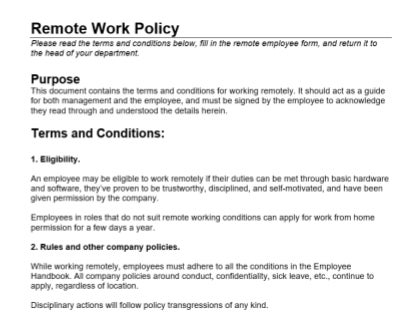
Remote Work Policy Template:
Use our Remote Work Policy Template as is or change some of the details to reflect your company's preferences.
Download NowThere is much to consider when putting together a remote work policy, and a lot of detail needs to be included in one if it is going to be a successful guide for employees working from home. Here are some questions you should be asking:
- Which roles can switch to remote work easily? Which roles can't?
- How will you ensure hourly-paid employees don't work too much overtime?
- Will you be compensating employees differently now? Are you going to pay some of their electricity and internet bills?
- What tools will your employees need? How will you make these available to them?
- How will your employees communicate and collaborate? What about meetings and check-ins?
- By which metrics will you be gauging performance?
- What rules apply to remote workers?
- Will remote workers still be eligible for training and promotion?
To get you started, we've put a version of our remote work policy template below for you to copy and paste into a document.
Remote Work Policy:
Please read the terms and conditions below, fill in the remote employee form, and return it to the head of your department.
Purpose
This document contains the terms and conditions for working remotely. It should act as a guide for both management and the employee and must be signed by the employee to acknowledge they read through and understood the details herein.
Terms and Conditions:
1. Eligibility.
An employee may be eligible to work remotely if their duties can be met through basic hardware and software, they’ve proven to be trustworthy, disciplined, and self-motivated, and have been given permission by the company.
Employees in roles that do not suit remote working conditions can apply for work from home permission for a few days a year.
2. Rules and other company policies.
While working remotely, employees must adhere to all the conditions in the Employee Handbook. All company policies around conduct, confidentiality, sick leave, etc., continue to apply, regardless of location.
Disciplinary actions will follow policy transgressions of any kind.
3. Work expectations.
Employees must follow the work schedules provided to them, be sure to meet deadlines, uphold high-quality standards, and submit daily reports. And while some flexibility is allowed, the employee must agree to work set hours as much as possible, five days a week.
Tools will be made available to employees for managing time and tasks, communicating with co-workers, logging and tracking projects, and accessing resources.
Performance will be measured weekly, focusing on the same metrics that apply to work done in the office.
4. Communication.
Employees are to be online and accessible for 8 hours, Monday to Friday. They are expected to check-in with their managers at least once a day.
Any correspondence from a co-worker or client must be answered as quickly as possible.
Tools have been provided for communicating with team members and collaborating on projects. Meetings will be scheduled for at least once a week. Times are to be discussed and agreed upon between the employee and the manager.
5. Insurance and liability.
Employees working remotely will still receive full company benefits, including health insurance and worker’s compensation.
Employees are advised to choose a safe and secure location to work from and to maintain high levels of safety. The company is liable for injuries suffered in the pre-defined workspace during work hours only.
Only equipment owned by the company and on loan to the employee is covered by the company’s chosen insurer. All other equipment is to be covered by the employee’s personal insurance provider.
6. Security.
As per the Employee Handbook and the confidentiality agreement signed by the employee upon employment, securing data and company information should be of utmost concern. Any breaches in security protocol will lead to strict and swift disciplinary action.
Employees will be given access to a Virtual Private Network to secure connections with company servers and networks. The VPN must be used at all times during work hours. Under no circumstances may the VPN be used outside of work hours.
Cybersecurity measures have been put in place, and the software will be made available.
7. Compensation.
No changes will be made to an employee’s salary if said employee works from home, full time. Salaries will increase according to company policy and successful performance reviews. Employees working remotely remain eligible for promotion and skills development programs.
The company will also reimburse the employee for electrical and internet costs if the employee follows the correct protocol for reimbursements.
Remote Employee Form
1. Employee Information:
Name: ________________
Job Title: ________________
Department: ________________
Supervisor: ________________
2. Remote Work Area:
Address: ________________
Phone Number: ________________
Workspace: ________________
3. Equipment:
Request: ________________
4. Authorization:
I have read, fully understand, and accept the terms and conditions described in this document. I understand and agree with all the expectations, duties, obligations, and responsibilities discussed in the document.
Employee: ________________
Supervisor:________________
How to Create a Remote Work Policy:
A step-by-step guide to creating an effective work from home policy.
Decide which roles can be done remotely.
Look for roles that can be done remotely but also those that can't.

Not all roles within an organization can be done remotely. While a software developer can easily perform their duties from home via a laptop and internet connection, a forklift driver can't. So it is important to know from the start which roles can shift from the office to the home, fluidly.
Then, look at those roles that are office-bound, or warehouse-bound and find out what duties can be performed remotely by those in these roles. Offer these employees a few days a year they can work from home.
During this crisis, wherein all employees have been sent home, find ways for all employees, regardless of role, to keep productive, check-in regularly, and perform as part of the team.
Re-establish the rules.
Determine what rules and company policies should be followed.

It is important to make clear that while employees no longer work at the office, rules, regulations, and policies may still apply. Usually, all standard company rules apply. Employees will appreciate knowing exactly what is expected of them in this regard.
Company policies and resources that still apply:
Develop work plans for remote workers.
Break down company objectives into measurable goals and responsibilities.

Along with heads of departments, break down company objectives into measurable goals and responsibilities. Assign managers to the task of outlining these work plans for each of their team members, discussing them with their teams, and then checking in to make sure goals are being achieved.
Determine what tools employees need to do their work from home.

Remote employees need the right technology and software to fulfill their individual duties from home, but also to collaborate with co-workers, communicate with supervisors, and generally feel part of a team.
Questions to ask:
What software will my team need?
Does everyone have a computer and internet connection at home? If not, what then?
What technical support can we provide to employees having technical difficulties?
Discuss how performance will be measured.

While tracking time logs has its uses, it isn't a very accurate method for tracking productivity. Decide by what metrics performance will be measured: the number of projects completed in a week, word count, closed sales, phone calls made, etc. Each role will have its own metrics.
Bring your employees in to discuss what they think are the best ways for measuring their contributions towards company goals and objectives.
Determine communication practices.
Be clear about what you expect of your employees when it comes to communicating.

The remote workforce relies heavily on clear communication for success. Your remote workers need to know how often you want them checking-in, through what channels they should be collaborating with others, when they will be needed in virtual meetings, etc.
There is a wide range of software available for hosting virtual meetings, collaborating, giving remote presentations, and managing projects. You'll need to stipulate what will be made available.
Questions to ask:
How quickly should they be responding to emails from colleagues and clients?
When will one-on-one meetings be?
When will team meetings be?
What is the procedure for giving clients virtual presentations?
Are their phones expected to be on 24/7?
How will they communicate what they've achieved each day?
What procedure should they follow for reporting any technical difficulties?
Discuss clearly issues of benefits, insurance, and liability.
Inform your employees of their rights as remote workers.

Even though the employee is not working from the office, their safety and security is still your concern. An air-tight remote work policy informs the employees of their rights, what would happen in case of injury, and to what extent the business is liable for any losses.
Questions to ask:
What equipment will be insured?
Is the employee still covered by worker's compensation?
In the case of injury, under what conditions will the company be liable?
What about health insurance?
Define security measures.
Re-emphasize the importance of confidentiality.

While your employees work from home it is extremely important they are kept on the same page about keeping confidential information and sensitive company data protected. This will already be stipulated in your company's confidentiality agreement, signed by employees, but it is worth revisiting.
Set up VPNs.

Each employee will probably need a VPN. Virtual private networks make connections to networks safer and more secure and hide browsing activity. They are an important security measure worth taking. Your policy needs to lay down the usage of the VPN.
Install cyber security software.

You'll be updating your cybersecurity with a remote workforce in mind. One of the main issues with having a remote workforce is that one can't be entirely certain about the safety and security of your employees' internet access. Their computers at home might be compromised. Determine what software will be needed and give your employees guidelines about using the software, etc.
Discuss compensation.
Be clear and open about changes to compensation.

You'll need to inform your employees of any changes to their benefits or salary as a result of working remotely. Set it down clearly what expenses employees can claim for, and the procedure by which to claim for these reimbursements.
Consult your employees on benefits and reimbursements. It will help you narrow down what is important to your employees.
How to Transition Employees to Working From Home


